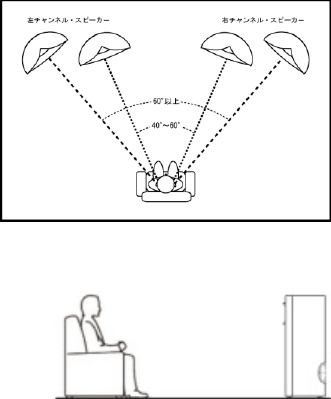
Project EVEREST DD66000
CHAPTER 7
Placement and Set-up Considerations
The Project EVEREST DD66000 loudspeaker system is designed to be less
affected by room acoustics than conventional imaging systems. However, it is
very sensitive to overall symmetry, proximity to walls, ceilings and corners.
Ideally, any listening room should contain a combination of live surfaces (e.g.,
walls and windows) and absorbent surfaces (e.g., drapes, carpets, upholstery).
If the distance between floor to ceiling is low, it is preferable that one surface
has an absorbent covering. With Project EVEREST DD66000, it is most
important to be able to accommodate the optimum listening area that is defined
by the 100° horizontal/60° vertical coverage pattern of the horn.
In order to obtain the best stereo effect, the speakers should be placed at the
same distance from the listening position.
• The distances to the right and left speakers are determined by the
relationship between the
distance from the listening
position to the speakers and the
angles of the speakers (refer to
the figure on the right). The
imaging qualities enable the
speakers to be placed relatively
far apart from each other, but
this weakens center imaging
such as vocal. By increasing
the inward angle of the
speakers toward the listener will improve the center imaging.
• The listener should be centered in
front of the speakers and furniture
should be of an appropriate height so
that when the listener is sitting, the ear
level is on a vertical plane with the
high-frequency horn (approximately
90 cm/ 35.5 in) as illustrated on the right.
• The surrounding environment for the speakers affect bass sound quality.
Placing the speakers close to wall behind them or side walls bring about
abundance of bass, but too close distance will result in dull bass. On the
other hand, too much distance will reduce the mass of bass but result is in


















